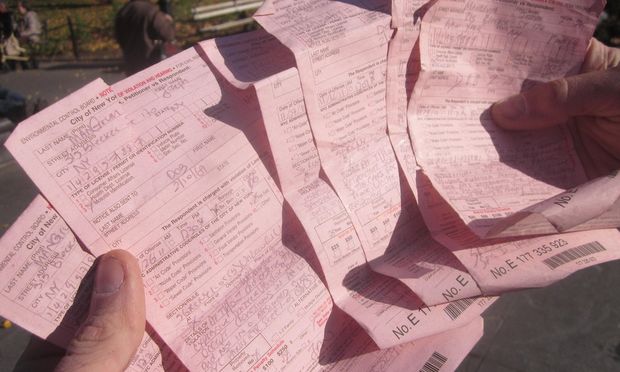
April 27, 2015, New York, NY – John Jay College of Criminal Justice today released a report on summonses issued in New York City from 2003-2013. The study offers an in-depth look at summons issuance patterns in the City’s five boroughs and two community courts from data provided by the Office of Court Administration. In the decade covered by the report, about a half-million summonses were issued each year.
President Jeremy Travis and Professor Preeti Chauhan presented key findings of the report at a Citizens Crime Commission breakfast this morning.
 “Summonses for low-level violations constitute the most frequent form of contact the public has with law enforcement,” said President Travis. “Our findings point to the need for policy discussions about this important, and under-examined, aspect of our criminal justice system.”
“Summonses for low-level violations constitute the most frequent form of contact the public has with law enforcement,” said President Travis. “Our findings point to the need for policy discussions about this important, and under-examined, aspect of our criminal justice system.”
Researchers focused on C-summonses, which are given for violations, sometimes referred to as “quality of life” offenses. On a daily basis, the number of summonses issued ranged from a high of about 1,600 in 2006 to a low of about 1,200 in 2013. The vast majority (over 97 percent) were issued by the New York City Police Department. The five most frequent charges in 2013 were public consumption of alcohol, disorderly conduct, public urination, park offenses, and riding a bicycle on the sidewalk.
 “There is significant variability in the dispositions of these charges,” said Professor Chauhan. “In 2013, almost half of public urination charges resulted in a guilty plea whereas almost half of riding your bicycle on the sidewalk charges resulted in a determination of legally insufficient prior to arraignment."
“There is significant variability in the dispositions of these charges,” said Professor Chauhan. “In 2013, almost half of public urination charges resulted in a guilty plea whereas almost half of riding your bicycle on the sidewalk charges resulted in a determination of legally insufficient prior to arraignment."
Key findings include:
- Overall, summonses are on the decline. This decline is driven by lower issuance rates among 16-17 year olds and 18-20 year olds, mainly for Disorderly Conduct.
- On average for the past decade, roughly 2 in 5 summonses resulted in a Dismissal or an Adjournment in Contemplation of Dismissal. Only 1 out of 5 summonses resulted in a disposition of Guilty.
- On average over the past decade, 36 percent of summonses resulted in the issuance of a warrant. The majority of these warrants were vacated and as of December 15, 2014, 14 percent of all summonses issued between 2003 and 2013 had an open warrant remaining.
- There is substantial borough-level variation throughout the summons process, in patterns of issuance, charges, and dispositions.
Chief Judge of the State of New York Jonathan Lippman, who made opening remarks at the event, noted: “Summons court handles more than half of the cases that make their way to the criminal courts in New York City each year. It is incumbent on the court system to ensure that these cases are being adjudicated fairly and successfully, from the perspectives of the litigants and the public. That is why we are currently implementing a series of measures to modernize the summons process to make it more effective in responding to quality of life offenses. We are committed to working with our partners in the criminal justice system as we consider further reforms to improve the summons process, and the comprehensive research undertaken by John Jay College of Criminal Justice will greatly assist those efforts.”
"The city is right now carrying out the important task of re-examining arrest policy and its impact on communities,” said Richard Aborn, President of the Citizens Crime Commission. “How summonses are handled is an integral part of that conversation —and this John Jay study provides an important, necessary and in-depth look into summonses that will help influence policy-making and ultimately make for more effective policing.”
The complete data analyses are documented in a full report entitled The Summons Report: Trends in Issuance and Dispositions of Summonses in New York City: 2003-2013.
With funding by the Laura and John Arnold Foundation, this is the second report prepared by the Misdemeanor Justice Project (MJP), a research initiative at John Jay College headed by Professor Chauhan that includes faculty, graduate students and staff.
The MJP’s first report, Trends in Misdemeanor Arrests in New York, was released in October 2014. The goal of the MJP is to deploy the tools of data analytics to provide a greater understanding of the interactions between the police and the public regarding low-level violations of the law.
The Citizens Crime Commission of New York City is a non-partisan non-profit organization working to make criminal justice and public safety policies and practices more effective through innovation, research, and education. In the last three decades, the Crime Commission has been a leader on key issues such as: increasing the size of the NYPD, expanding the use of DNA evidence in crime fighting, creating innovations that reduce juvenile crime, developing interventions against gun violence and illegal gun crime, and highlighting the changing nature of the threat of terrorism. For more information, visit www.nycrimecommission.org.
About John Jay College of Criminal Justice: An international leader in educating for justice, John Jay College of Criminal Justice of The City University of New York offers a rich liberal arts and professional studies curriculum to upwards of 15,000 undergraduate and graduate students from more than 135 nations. In teaching, scholarship and research, the College approaches justice as an applied art and science in service to society and as an ongoing conversation about fundamental human desires for fairness, equality and the rule of law. For more information, visit www.jjay.cuny.edu.



